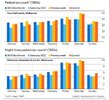Dona Ferentes
Pengurus pengatur
- Joined
- 11 January 2016
- Posts
- 16,237
- Reactions
- 22,166
Back on theme, assuming foot traffic translates to dollars spent. And it would be fair to assume the city is an 'event destination' with workers still not returning as beforr 2020, and likely flexible work is as attractive ad working from home. .....
Sundays now busier than Mondays, and evening activity significantly higher, new data from the City of Melbourne reveals.
Peak-hour commuter activity at Flinders Street Station remains just 59 per cent of pre-COVID levels. Tuesday is the busiest day, at 64 per cent, amid the decline of the Monday to Friday city office worker.
The retail sector is suffering, with foot traffic near the Bourke Street Mall just 71 per cent of pre-COVID levels. Foot traffic is now highest on a Saturday.
However, families and workers are coming into the city much more at night and on the weekends and international students have returned, pushing up night-time activity by 24 per cent increase across the city in June.
Student activity near Melbourne University is also returning, up 20 per cent compared to the same time last year and strongest on Tuesdays, Wednesdays and Thursdays and now at 82 per cent of pre-COVID levels.

Sundays now busier than Mondays, and evening activity significantly higher, new data from the City of Melbourne reveals.
Peak-hour commuter activity at Flinders Street Station remains just 59 per cent of pre-COVID levels. Tuesday is the busiest day, at 64 per cent, amid the decline of the Monday to Friday city office worker.
The retail sector is suffering, with foot traffic near the Bourke Street Mall just 71 per cent of pre-COVID levels. Foot traffic is now highest on a Saturday.
However, families and workers are coming into the city much more at night and on the weekends and international students have returned, pushing up night-time activity by 24 per cent increase across the city in June.
Student activity near Melbourne University is also returning, up 20 per cent compared to the same time last year and strongest on Tuesdays, Wednesdays and Thursdays and now at 82 per cent of pre-COVID levels.


